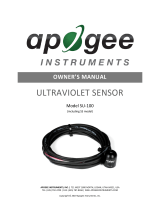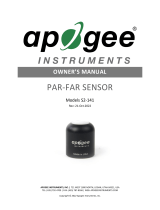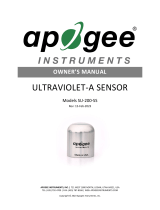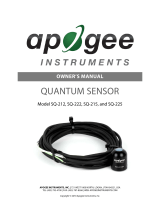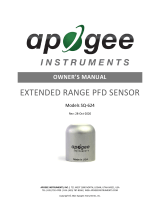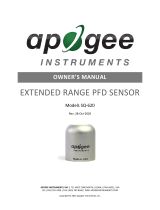Page is loading ...

APOGEE INSTRUMENTS, INC. | 721 WEST 1800 NORTH, LOGAN, UTAH 84321, USA
TEL: (435) 792-4700 | FAX: (435) 787-8268 | WEB: APOGEEINSTRUMENTS.COM
Copyright © 2022 Apogee Instruments, Inc.
OWNER’S MANUAL
QUANTUM METER
Models MQ-100X and MQ-200X
Rev: 30-Aug-2022

TABLE OF CONTENTS
Owner’s Manual ............................................................................................................................................................................... 1
Certificates of Compliance ....................................................................................................................................................... 3
Introduction ............................................................................................................................................................................. 5
Sensor Models ......................................................................................................................................................................... 6
Specifications ........................................................................................................................................................................... 7
Deployment and Installation .................................................................................................................................................. 10
Battery Installation and Replacement .................................................................................................................................... 11
Operation and Measurement ................................................................................................................................................ 12
Apogee AMS Software ........................................................................................................................................................... 16
Maintenance and Recalibration ............................................................................................................................................. 18
Troubleshooting and Customer Support ................................................................................................................................ 20
Return and Warranty Policy ................................................................................................................................................... 22

CERTIFICATE OF COMPLIANCE
EU Declaration of Conformity
This declaration of conformity is issued under the sole responsibility of the manufacturer:
Apogee Instruments, Inc.
721 W 1800 N
Logan, Utah 84321
USA
for the following product(s):
Models: MQ-100X, MQ-200X
Type: Quantum Meter
The object of the declaration described above is in conformity with the relevant Union harmonization legislation:
2014/30/EU Electromagnetic Compatibility (EMC) Directive
2011/65/EU Restriction of Hazardous Substances (RoHS 2) Directive
2015/863/EU Amending Annex II to Directive 2011/65/EU (RoHS 3)
Standards referenced during compliance assessment:
EN 61326-1:2013 Electrical equipment for measurement, control, and laboratory use – EMC requirements
EN 63000:2018 Technical documentation for the assessment of electrical and electronic products with
respect to the restriction of hazardous substances
Please be advised that based on the information available to us from our raw material suppliers, the products
manufactured by us do not contain, as intentional additives, any of the restricted materials including lead (see
note below), mercury, cadmium, hexavalent chromium, polybrominated biphenyls (PBB), polybrominated
diphenyls (PBDE), bis (2-ethylhexyl) phthalate (DEHP), butyl benzyl phthalate (BBP), dibutyl phthalate (DBP), and
diisobutyl phthalate (DIBP). However, please note that articles containing greater than 0.1 % lead concentration
are RoHS 3 compliant using exemption 6c.
Further note that Apogee Instruments does not specifically run any analysis on our raw materials or end products
for the presence of these substances, but we rely on the information provided to us by our material suppliers.
Signed for and on behalf of:
Apogee Instruments, August 2022
Bruce Bugbee
President
Apogee Instruments, Inc.

CERTIFICATE OF COMPLIANCE
UK Declaration of Conformity
This declaration of conformity is issued under the sole responsibility of the manufacturer:
Apogee Instruments, Inc.
721 W 1800 N
Logan, Utah 84321
USA
for the following product(s):
Models: MQ-100X, MQ-200X
Type: Quantum Meter
The object of the declaration described above is in conformity with the relevant UK Statutory Instruments and
their amendments:
2016 No. 1091 The Electromagnetic Compatibility Regulations 2016
2012 No. 3032 The Restriction of the Use of Certain Hazardous Substances in Electrical and Electronic
Equipment Regulations 2012
Standards referenced during compliance assessment:
BS EN 61326-1:2013 Electrical equipment for measurement, control, and laboratory use – EMC requirements
BS EN 63000:2018 Technical documentation for the assessment of electrical and electronic products with
respect to the restriction of hazardous substances
Please be advised that based on the information available to us from our raw material suppliers, the products
manufactured by us do not contain, as intentional additives, any of the restricted materials including lead (see
note below), mercury, cadmium, hexavalent chromium, polybrominated biphenyls (PBB), polybrominated
diphenyls (PBDE), bis (2-ethylhexyl) phthalate (DEHP), butyl benzyl phthalate (BBP), dibutyl phthalate (DBP), and
diisobutyl phthalate (DIBP). However, please note that articles containing greater than 0.1 % lead concentration
are RoHS 3 compliant using exemption 6c.
Further note that Apogee Instruments does not specifically run any analysis on our raw materials or end products
for the presence of these substances, but we rely on the information provided to us by our material suppliers.
Signed for and on behalf of:
Apogee Instruments, August 2022
Bruce Bugbee
President
Apogee Instruments, Inc.

INTRODUCTION
Radiation that drives photosynthesis is called photosynthetically active radiation (PAR) and is typically defined as
total radiation across a range of 400 to 700 nm. PAR is often expressed as photosynthetic photon flux density
(PPFD): photon flux in units of micromoles per square meter per second (µmol m-2 s-1, equal to microEinsteins per
square meter per second) summed from 400 to 700 nm (total number of photons from 400 to 700 nm). While
Einsteins and micromoles are equal (one Einstein = one mole of photons), the Einstein is not an SI unit, so
expressing PPFD as µmol m-2 s-1 is preferred.
The acronym PPF is also widely used and refers to the photosynthetic photon flux. The acronyms PPF and PPFD
refer to the same variable. The two terms have co-evolved because there is not a universal definition of the term
“flux”. Some physicists define flux as per unit area per unit time. Others define flux only as per unit time. We
have used PPFD in this manual because we feel that it is better to be more complete and possibly redundant.
Sensors that measure PPFD are often called quantum sensors due to the quantized nature of radiation. A quantum
refers to the minimum quantity of radiation, one photon, involved in physical interactions (e.g., absorption by
photosynthetic pigments). In other words, one photon is a single quantum of radiation.
Typical applications of quantum sensors include incoming PPFD measurement over plant canopies in outdoor
environments or in greenhouses and growth chambers and reflected or under-canopy (transmitted) PPFD
measurement in the same environments.
Apogee Instruments MQX series quantum meters consist of a handheld meter and a dedicated quantum sensor
that is integrated into the top of the meter housing (MQ-100X) or connected by cable to an anodized aluminum
housing (MQ-200X). Integrated and separate sensors consist of a cast acrylic diffuser (filter), photodiode, and are
potted solid with no internal air space. MQX series quantum meters provide a real-time PPFD reading on the LCD
display and offer measurements that determine the radiation incident on a planar surface (does not have to be
horizontal), where the radiation emanates from all angles of a hemisphere. MQX series quantum meters include
manual and automatic data logging features for making spot-check measurements or calculating daily light integral
(DLI).

SENSOR MODELS
Apogee MQX series quantum meters covered in this manual are self-contained and come complete with handheld
meter and sensor.
A sensor’s model number and serial
number are located on a label on
the backside of the handheld meter.
MQ-100X:
Meter w/ integral
sensor
MQ-200X:
Meter w/ separate
sensor

SPECIFICATIONS
Calibration Traceability
Apogee MQX series quantum meters are calibrated through side-by-side comparison to the mean of four transfer
standard quantum sensors under a reference lamp. The reference quantum sensors are recalibrated with a 200 W
quartz halogen lamp traceable to the National Institute of Standards and Technology (NIST).
MQ-100X
MQ-200X
Calibration
Uncertainty
± 5 % (see calibration Traceability below)
Measurement
Repeatability
Less than 1 %
Long-term Drift
(Non-stability)
Less than 2 % per year
Non-linearity
Less than 1 % (up to 2500 µmol m-2 s-1)
Response Time
Less than 1 ms
Field of View
180°
Spectral Range
370 to 650 nm (wavelengths where response is greater than 50 % of maximum; see
Spectral Response below)
Directional (Cosine)
Response
± 5 % at 75° zenith angle (see Cosine Response below)
Temperature
Response
-0.04 % per C (see Temperature Response below)
Operating
Environment
0 to 50 C; less than 90 % non-condensing relative humidity up to 30 C; less than 70 %
non-condensing relative humidity from 30 to 50 C; separate sensors can be
submerged in water up to depths of 30 m
Meter Dimensions
126 mm length; 70 mm width; 24 mm height
Sensor Dimensions
Integrated w/ Meter
24 mm diameter; 33 mm height
Mass
150 g
180 g
Cable
2 m of two conductor, shielded, twisted pair wire; TPR jacket (high water resistance,
high UV stability, flexibility in cold conditions)

Spectral Response
Mean spectral response of four MQ-100x
series quantum sensors compared to PPFD
weighting function. Spectral response
measurements were made at 10 nm
increments across a wavelength range of
350 to 800 nm in a monochromator with
an attached electric light source. Measured
spectral data from each quantum sensor
were normalized by the measured spectral
response of the monochromator/electric
light combination, which was measured
with a spectroradiometer.

Cosine Response
Mean cosine response of five MQ-
100X series quantum sensors.
Cosine response measurements
were made by direct side-by-side
comparison to the mean of seven
reference SQ-500 quantum
sensors.
Directional, or cosine, response is defined
as the measurement error at a specific
angle of radiation incidence. Error for
Apogee MQ-100X series quantum sensors
is approximately ± 2 % and ± 5 % at solar
zenith angles of 45° and 75°, respectively.

AM-320 Saltwater Submersible
Sensor Wand
AM-310 Extendable Sensor
Wand
DEPLOYMENT AND INSTALLATION
Apogee MQX series quantum meters are designed for spot-check measurements, and calculation of daily light
integral (DLI; total number of photons incident on a planar surface over the course of a day) through the built-in
logging feature. To accurately measure PFFD incident on a horizontal surface, the sensor must be level. For this
purpose, each MQX model comes with a different option for mounting the sensor to a horizontal plane.
The AM-310 Sensor Wand accessory incorporates a mounting fixture at the end of an extendable telescopic wand
(up to 33 inches/84 cm). The wand is not suited for wet environments; however, it is excellent for greenhouses and
growth chambers. Its ability to retract to a smaller size also makes it ideal for travel use.
The AM-320 Saltwater Submersible Sensor Wand accessory incorporates a mounting fixture at the end of a 40-inch
segmented fiberglass wand and is well-suited for saltwater use. The wand allows the user to place the sensor in
hard-to-reach areas such as aquariums.
NOTE: The handheld meter portion of the instrument is not waterproof. Do not get the meter wet or leave the
meter in high humidity environments for prolonged periods of time. Doing so can lead to corrosion that could void
the warranty.
The AL-210 leveling plate is recommended
for use with the MQ-100X.
The AL-100 leveling plate is recommended
for use with the MQ-200X. To facilitate
mounting to a cross arm, the AL-120
mounting bracket is recommended.

BATTERY INSTALLATION AND REPLACEMENT
Use a Phillips head screwdriver to remove the screw from the battery cover. Remove the battery cover by slightly
lifting and sliding the outer edge of the cover away from the meter.
To power the meter, slide the included battery (CR2320) into the battery holder, after removing the battery door
from the meter’s back panel.
The positive side (designated by a “+” sign) should be facing out from the meter circuit board.
NOTE: The battery cradle can be damaged by using an incorrectly sized battery. If the battery cradle is damaged,
the circuit board will need to be replaced and the warranty will be void. To avoid this costly problem, use only a
CR2320 battery.
Battery Removal
Press down on the battery with a screwdriver or similar object. Slide battery out.
If the battery is difficult to move, turn the meter on its side so that the opening for the battery is facing downward
and tap the meter downward against an open palm to dislodge the battery enough so that it can be removed with
your thumb to slide the battery out of the battery holder.

OPERATION AND MEASUREMENT
MQX series quantum meters are designed with a user-friendly interface allowing quick and easy measurements.
To power the meter, slide the included battery (CR2320) into the battery holder, after removing the battery
door from the meter’s back panel. The positive side (designated by a “+” sign) should be facing out from the meter
circuit board.
Press the power button to activate the LCD display. After two minutes of non-activity the meter will revert
to sleep mode and the display will shut off to conserve battery life.
Press the mode button to access the main menu, where manual or automatic logging are selected, and
where the meter can be reset.
Press the sample button to log a reading while taking manual measurements.
Press the up button to make selections in the main menu. This button is also used to view and scroll
through the logged measurements on the LCD display.
Press the down button to make selections in the main menu. This button is also used to view and scroll
through the logged measurements on the LCD display.
Logging: To choose between manual or automatic logging, push the mode button once and use the up/down
buttons to make the appropriate selection (SMPL or LOG). Once the desired mode is blinking, press the mode
button two more times to exit the menu. When in SMPL mode press the sample button to record up to 99 manual
measurements (a counter in the upper right-hand corner of the LCD display indicates the total number of saved
measurements). When in LOG mode the meter will power on/off to make a measurement every 30 seconds. Every
30 minutes the meter will average the sixty 30 second measurements and record the averaged value to memory.
The meter can store up to 99 averages and will start to overwrite the oldest measurement once there are 99
measurements. Every 48 averaged measurements (making a 24-hour period), the meter will also store an
integrated daily total in moles per meter squared per day (mol m-2 d-1).
The LCD display consists of the total number of logged
measurements in the upper right-hand corner, the
real-time PPFD value in the center, and the selected
menu options along the bottom.

Reset: To reset the meter, in either SMPL or LOG mode, push the mode button three times (RUN should be
blinking), then while pressing the down button, press the mode button once. This will erase all of the saved
measurements in memory, but only for the selected mode. That is, performing a reset when in SMPL mode will
only erase the manual measurements and performing a reset when in LOG mode will only erase the automatic
measurements.
Review/Download Data: Each of the logged measurements in either SMPL or LOG mode can be reviewed on the
LCD display by pressing the up/down buttons. To exit and return to the real-time readings, press the sample
button. Note that the integrated daily total values are not accessible through the LCD and can only be viewed by
downloading to a computer.
Downloading the stored measurements will require the AC-100 communication cable and software (sold
separately). The meter outputs data using the UART protocol and requires the AC-100 to convert from UART to
USB, so standard USB cables will not work. Set up instructions and software can be downloaded from the Apogee
website (http://www.apogeeinstruments.com/ac-100-communcation-cable/).

Spectral Errors
Apogee SQ-100X series sensors can measure PPFD for sunlight and electric light with a single calibration factor.
However, errors occur in various light sources due to changes in spectral output. If the light source spectrum is
known, then errors can be estimated and used to adjust the measurements. The weighting function for PPFD is
shown in the graph below, along with the spectral response of Apogee SQ-100X series quantum sensors. The closer
the spectral response matches the defined PPFD spectral weighting functions, the smaller spectral errors will be.
The table below provides spectral error estimates for PPFD measurements from light sources different than the
calibration source. The method of Federer and Tanner (1966) was used to determine spectral errors based on the
PPFD spectral weighting functions, measured sensor spectral response, and radiation source spectral outputs
(measured with a spectroradiometer). This method calculates spectral error and does not consider calibration,
cosine, and temperature errors.
Federer, C. A., and C. B. Tanner, 1966. Sensors for measuring light available for photosynthesis. Ecology 47:654-
657.
McCree, K. J., 1972. The action spectrum, absorptance and quantum yield of photosynthesis in crop plants.
Agricultural Meteorology 9:191-216.
Spectral Errors for PPFD Measurements with Apogee SQ-100x and SQ-500 Series Quantum Sensors
Radiation Source (Error Calculated Relative to Sun, Clear Sky)
SQ-100X Series
PPFD Error [%]
Sun (Clear Sky)
0.0
Sun (Cloudy Sky)
0.2
Reflected from Grass Canopy
5.0
Transmitted below Wheat Canopy
7.0
Cool White Fluorescent (T5)
7.2
Metal Halide
6.9
Ceramic Metal Halide
-8.8
High Pressure Sodium
3.3
Blue LED (448 nm peak, 20 nm full-width half-maximum)
14.5
Green LED (524 nm peak, 30 nm full-width half-maximum)
29.6
Red LED (635 nm peak, 20 nm full-width half-maximum)
-30.9
Red LED (667 nm peak, 20 nm full-width half-maximum)
-56.7
Red, Blue LED Mixture (80 % Red, 20 % Blue)
-21.2
Red, Blue, White LED Mixture (60 % Red, 25 % White, 15 % Blue)
-29.7
Cool White LED
7.3
Warm White LED
-7.8
Quantum sensors can be a very practical means of measuring PPFD and YPFD from multiple radiation sources, but
spectral errors must be considered. The spectral errors in the table above can be used as correction factors for
individual radiation sources.

Underwater Measurements and Immersion Effect
When a quantum sensor that was calibrated in air is used to make underwater measurements, the sensor reads
low. This phenomenon is called the immersion effect and happens because the refractive index of water (1.33) is
greater than air (1.00). The higher refractive index of water causes more light to be backscattered (or reflected)
out of the sensor in water than in air (Smith,1969; Tyler and Smith,1970). As more light is reflected, less light is
transmitted through the diffuser to the detector, which causes the sensor to read low. Without correcting for this
effect, underwater measurements are only relative, which makes it difficult to compare light in different
environments.
The SQ-100X series sensors have an immersion effect correction factor of 1.15. This correction factor should be
multiplied to measurements made underwater.
NOTE: The handheld meter portion of the instrument is not waterproof. Do not get the meter wet or leave the
meter in high humidity environments for prolonged periods of time. Doing so can lead to corrosion that could void
the warranty.
Further information on underwater measurements and the immersion effect can be found at
http://www.apogeeinstruments.com/underwater-par-measurements/.
Smith, R.C., 1969. An underwater spectral irradiance collector. Journal of Marine Research 27:341-351.
Tyler, J.E., and R.C. Smith, 1970. Measurements of Spectral Irradiance Underwater. Gordon and Breach, New York,
New York. 103 pages

APOGEE AMS SOFTWARE
Downloading data to a computer requires the AC-100 communication cable and the free ApogeeAMS software.
The meter outputs data using the UART protocol and requires the AC-100 to convert from UART to USB, so
standard USB cables will not work.
The most recent version of ApogeeAMS software can be downloaded at
http://www.apogeeinstruments.com/downloads/.
When the ApogeeAMS software is first opened, it will
show a blank screen until communication with the meter
is established. If you click “Open Port” it will say
“connection failed.”
To establish communication, make sure the meter is
plugged into your computer using the AC-100
communication cable. To connect click the dropdown
menu button and “COM#” options will appear. For more
details on how to figure out which COM is the right one,
watch our video.
When you have connected to the correct COM#, the
software will say “Connected”.
Click “Sample Data” to view saved sample readings.

“Daily Totals” shows all the saved Daily Light Integral
(DLI) totals per day.
Click “30 Min Avg” to see the meter’s 99, 30-minute
averages.
To analyze the data, click on “File” and “Save As” to save
the data as a .csv file.
Or you can highlight the numbers, copy, and paste them
into a blank Excel spreadsheet. Data will need to be
comma delimited.

MAINTENANCE AND RECALIBRATION
Blocking of the optical path between the target and detector can cause low readings. Occasionally, accumulated
materials on the diffuser of the sensor can block the optical path in three common ways:
1. Moisture or debris on the diffuser.
2. Dust during periods of low rainfall.
3. Salt deposit accumulation from evaporation of sea spray or sprinkler irrigation water.
Apogee Instruments quantum sensors have a domed diffuser and housing for improved self-cleaning from rainfall,
but active cleaning may be necessary. Dust or organic deposits are best removed using water, or window cleaner,
and a soft cloth or cotton swab. Salt deposits should be dissolved with vinegar and removed with a cloth or cotton
swab. Salt deposits cannot be removed with solvents such as alcohol or acetone. Use only gentle pressure when
cleaning the diffuser with a cotton swab or soft cloth to avoid scratching the outer surface. The solvent should be
allowed to do the cleaning, not mechanical force. Never use abrasive material or cleaner on the diffuser.
Although Apogee sensors are very stable, nominal calibration drift is normal for all research-grade sensors. To
ensure maximum accuracy, recalibration every two years is recommended. Longer time periods between
recalibration may be warranted depending on tolerances. See the Apogee webpage for details regarding return of
sensors for recalibration (http://www.apogeeinstruments.com/tech-support-recalibration-repairs/).
To determine if your sensor needs recalibration, the Clear Sky Calculator (www.clearskycalculator.com) website
and/or smartphone app can be used to indicate the PPFD incident on a horizontal surface at any time of day at any
location in the world. It is most accurate when used near solar noon in spring and summer months, where
accuracy over multiple clear and unpolluted days is estimated to be ± 4 % in all climates and locations around the
world. For best accuracy, the sky must be completely clear, as reflected light from clouds causes PPFD to increase
above the value predicted by the clear sky calculator. Measured values of PPFD can exceed values predicted by the
Clear Sky Calculator due to reflection from thin, high clouds and edges of clouds, which enhances incoming PPFD.
The influence of high clouds typically shows up as spikes above clear sky values, not a constant offset greater than
clear sky values.
To determine recalibration need, input site conditions into the calculator and compare PPFD measurements to
calculated values for a clear sky. If sensor PPFD measurements over multiple days near solar noon are consistently
different than calculated values (by more than 6 %), the sensor should be cleaned and re-leveled. If measurements
are still different after a second test, email calibration@apogeeinstruments.com to discuss test results and
possible return of sensor(s).

Homepage of the Clear Sky
Calculator. Two calculators are
available: one for quantum sensors
(PPFD) and one for pyranometers
(total shortwave radiation).
Clear Sky Calculator for quantum
sensors. Site data are input in blue
cells in middle of page and an
estimate of PPFD is returned on
right-hand side of page.

TROUBLESHOOTING AND CUSTOMER SUPPORT
Verify Functionality
Pressing the power button should activate the LCD and provide a real-time PPFD reading. Direct the sensor head
toward a light source and verify the PPFD reading responds. Increase and decrease the distance from the sensor to
the light source to verify that the reading changes proportionally (decreasing PPFD with increasing distance and
increasing PPFD with decreasing distance). Blocking all radiation from the sensor should force the PPFD reading to
zero.
Battery Life
When the meter is maintained properly the coin cell battery (CR2320) should last for many months, even after
continuous use. The low battery indicator will appear in the upper left-hand corner of the LCD display when the
battery voltage drops below 2.8 V DC. The meter will still function correctly for some time, but once the battery is
drained the pushbuttons will no longer respond and any logged measurements will be lost.
Pressing the power button to turn off the meter will actually put it in sleep mode, where there is still a slight
amount of current draw. This is necessary to maintain the logged measurements in memory. Therefore, it is
recommended to remove the battery when storing the meter for many months at a time, in order to preserve
battery life.
Low-Battery Error after Battery Replacement
A master reset will usually correct this error, please see the master reset section for details and cautions. If a
master reset does not remove the low battery indicator, please double check that the voltage of your new battery
is above 2.8 V, this is the threshold for the indicator to turn on.
Master Reset
If a meter ever becomes non-responsive or experiences anomalies, such as a low battery indicator even after
replacing the old battery, a master reset can be performed that may correct the problem. Note that a master reset
will erase all logged measurements from memory.
Step 1: press the power button so that the LCD display is activated.
Step 2: Slide the battery out of the holder, which will cause the LCD display to fade out.
Step 3: After a few seconds, slide the battery back into the holder.
The LCD display will flash all segments and then show a revision number (e.g., “R1.0”). This indicates the master
reset was performed and the display should return to normal.
/

